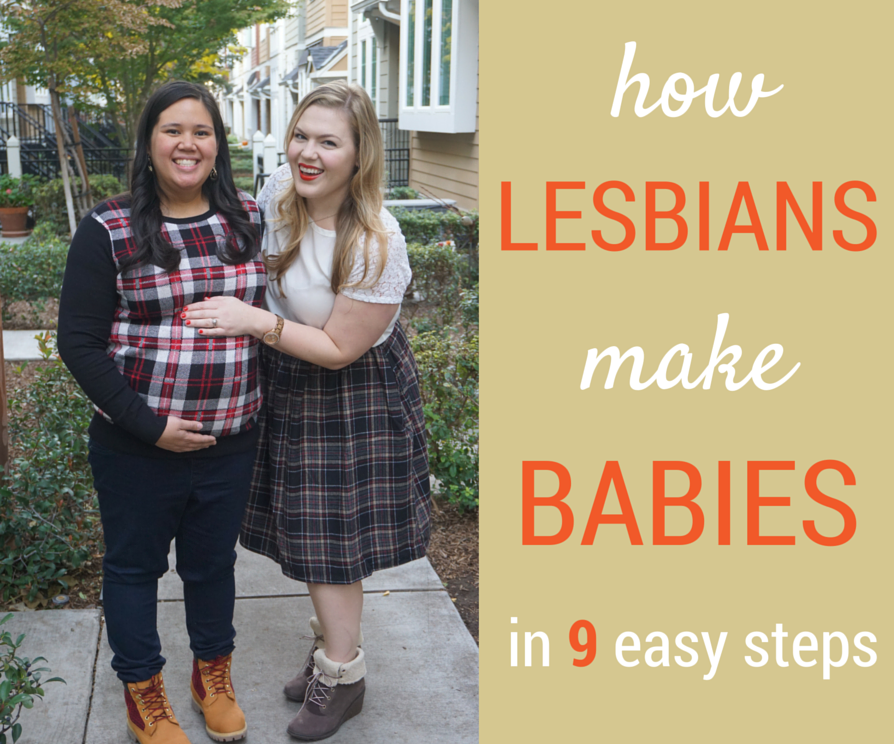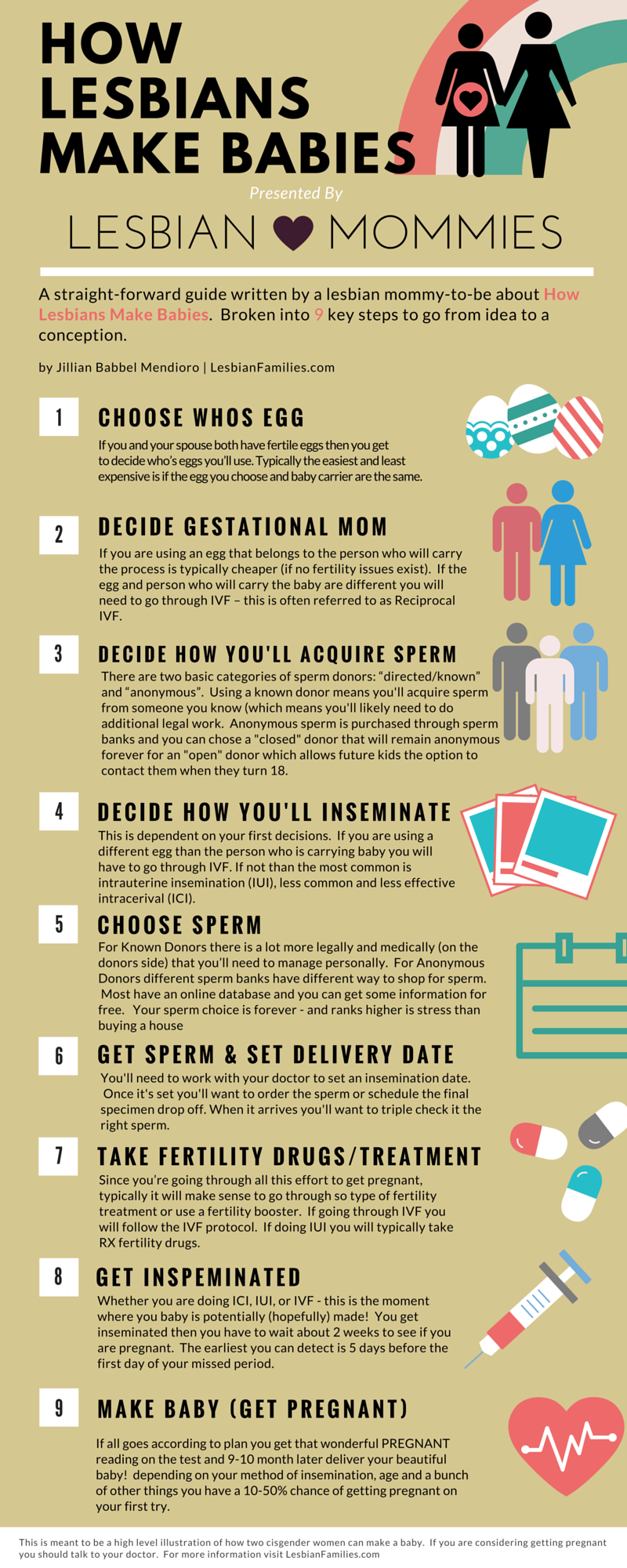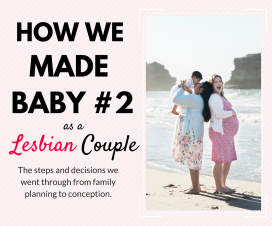A straight-forward guide written by a lesbian mommy-to-be about How Lesbians Make Babies. Broken into 9 key steps to go from idea to a conception.

This post originally appeared on Our Toasty Life.
There are quite a few options (or decisions) when it comes to making a baby. Some decisions need to be made in order so I’ve tried to lay out all the options/decision in the order that is most typically followed, however keep in mind this is meant to be a reference and every person’s journey to pregnancy is different. Additionally, I’ve left adoption, DIY insemination and natural insemination off this list, because they could be whole other blog posts and I don’t have the expertise.
Also you should definitely work with a fertility doctor if you are thinking of trying to conceive. For me it was helpful to generally understand the process before we went to our appointment. Depending on what options you choose you will have other tests/procedures done. This posts highlights the majors decisions/steps you’ll make 🙂
How Lesbians Make Babies:
- Decide who’s egg will you use
- Decide who will carry
- Decide how to will your pick your sperm donor
- Decide how will you inseminate
- Select Sperm Donor
- Order Sperm and Set Delivery Date or Known Donor Specimen Drop-Off
- Go through fertility treatments (if needed)
- Get inseminated
- Conceive
1. Decide whose egg will you use
If you and your spouse both have fertile eggs then you get to choose who’s eggs you’ll use. There are so many things that can go into this decision. Here are a few questions to get you started
- Do either of you have any genetic precursors that could factor in?
- Do both of you want to be pregnant at one point in time?
- How old are you and what is your baby making timeline?
- Who will be the primary caretaker?
- What are your benefits like?
- Cost – it is typically cheaper if the person carrying the baby uses their own egg.
2. Decide who will carry
Being pregnant is a LOT of work. It’s basically a 9-10 month marathon of exhaustion, alien body symptoms, nausea, etc. resulting is the most amazing gift: a new baby (or two)! If you are using an egg that belongs to the person who will carry the process is typically cheaper (if no fertility issues). If the egg and person who will carry the baby are different you will need to go through IVF – this is often referred to as Reciprocal IVF. More info here. The carrying mom is typically referred to gestational parent/mom (Using the term “bio-mom/non-bio-mom” can be incorrect and disrespectful).
3. Decide how you will your pick your sperm donor
There are two basic categories of sperm donors: “directed/known” and “anonymous”
Know/Directed Donor
If you are using a known donor – there can potentially a whole process you go through with that as well. Here is one example. When using a known donor you will definitely need to get some legal paperwork in place and laws can differ drastically depending on where you live. Here is some more info from the HRC.
Anonymous Donor
Any sperm you will purchase from a bank is anonymous sperm. There are many option you can make about sperm and different sperm banks give you different options and information. There are two categories of anonymous sperm donors: open and closed.
Anonymous Open
These sperm donors legally agree to have their information shared with all kids made from their sperm when they turn 18.
Anonymous Closed
These sperm donors will remain anonymous forever.
4. Decide how will you inseminate
This is dependent on your first decisions. If you are using a different egg than the person who is carrying baby you will have to go through IVF. IVF is the process of fertilization by manually combining an egg and sperm in a laboratory dish, and then transferring the embryo to the uterus. If egg and baby carrier are the same, then you have a couple options: Inter Cervical Insemination (ICI) or Inter Utero Incemination ( IUI).
ICI
If you plan to perform an intra-cervical insemination (also known as vaginal insemination) which is the placement of the sperm near, but not inside of the cervix, the ICI preparation is suitable. You can think of this as medical grade turkey baseter. Semen won’t be washed away from the sperm and this method could be used if you had a known donor who could provide a specimen at home for insemination.
IUI
Sperm is prepared for IUI by washing the sperm to get rid of all semen and any other fluid that is not sperm. A catheter is inserted into the uterus and sperm is placed directly in the uterus.
This is most typically how sperm is prepared when purchasing from a sperm bank.
5. Choose Sperm
For Known Donors
Like mentioned earlier, there is a lot more legally and medically (on the donors side) that you’ll need to manage personally (as opposed to if you use a sperm bank they take care of all of that as part of their services). You’ll need to spend time to have the donor get their sperm check, plus a hosts of other tests. Here’s an example of the process from CA Cryobank (the one we used).
For Anonymous Donors
Different sperm banks have different way to shop for sperm. Most have an online database and you can get some information for free. There are SO many options to pick from that it’s helpful to have some filters in mind. Other things that are good to keep in mind is sperm availability and if you want to use the same sperm for multiple pregnancies.
Which is better? That’s up to you and your family. Here is a helpful blog that has some pros/cons to think about.
6. Order Sperm & Set Delivery Date OR schedule final specimen drop off
You’ll need to work with your doctor to set an insemination date. Once it’s set you’ll want to order the sperm or schedule the final specimen drop off. Depending on what you choose and your doctor, you will either have it delivered to your house then brought in, or delivered/donated at the doctor’s office. When it arrives you’ll want to triple check it the right sperm
7. Go through Fertility Treatments
Since you’re going through all this effort to get pregnant, typically it will make sense to go through so type of fertility treatment or use a fertility booster.
Fertility Drugs
In general, fertility drugs work by causing the release of hormones that either trigger or regulate ovulation. The main types of fertiilty dugs are Clomiphene (brand names: Clomid and Serophene) and Gonadotropins (Brand names: Repronex, Menopur, Bravelle, Follistim, Gonal-F)
Fertility Treatments
The are a vast array of fertility treatments depending on what you’re trying to do. Here’s a great article with an IVF specialist talking about reciprocal IVF. You’ll definitely want to discuss this with your doctor.
8. Get inseminated
Whether you are doing ICI, IUI, or IVF – this is the moment where you baby is potentially (hopefully) made! You get inseminated then you have to wait about 2 weeks to see if you are pregnant. The earliest you can detent is 5 days before the first day of your missed period. You will likely get some blood test before this to see how your hormones are coming along and make sure your uterus is happy.
9. Conceive
If all goes according to plan you get that wonderful PREGNANT reading on the test and 9-10 month later deliver your beautiful baby! depending on your method of insemination, age and a bunch of other things you have a 10-50% chance of getting pregnant on your first try. Finding research for lesbian success rates is hard, as the majority of studies are for women who have fertility challenges. For lesbian trying to conceive this may be the case with some women, but likely not as high of a percentage.
And there you have it! Hope this was a helpful walk-through of the option available and good luck to all the folks out there trying to make a baby!




